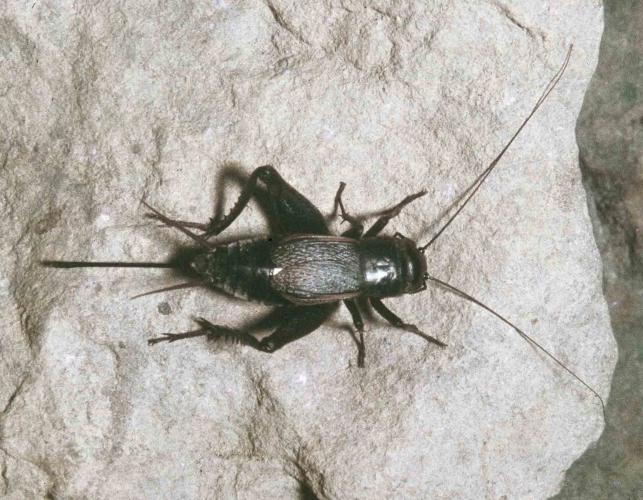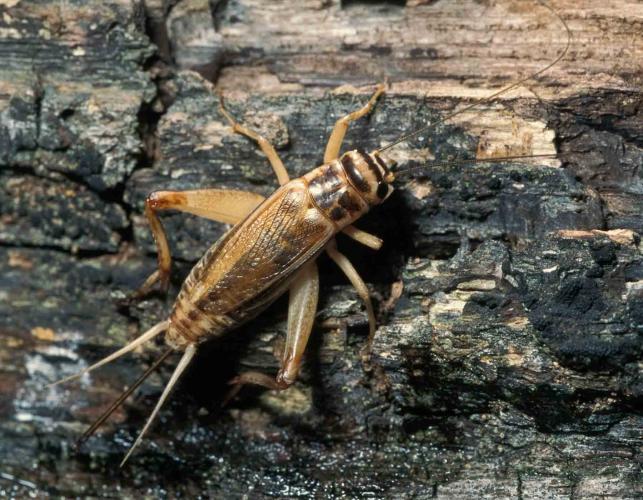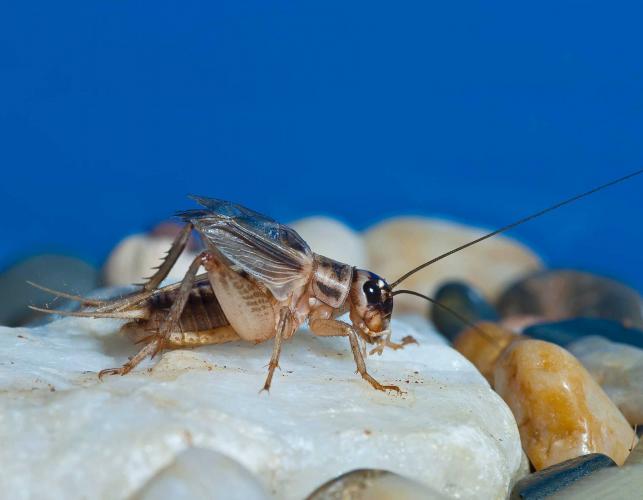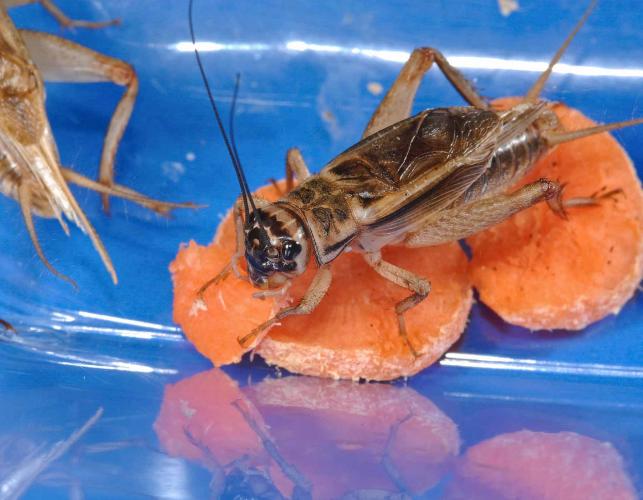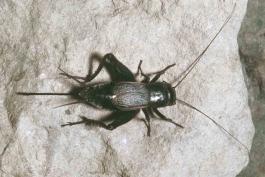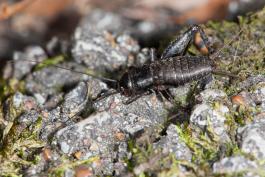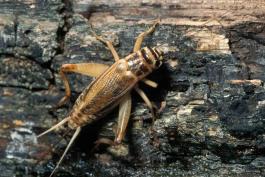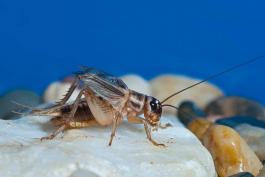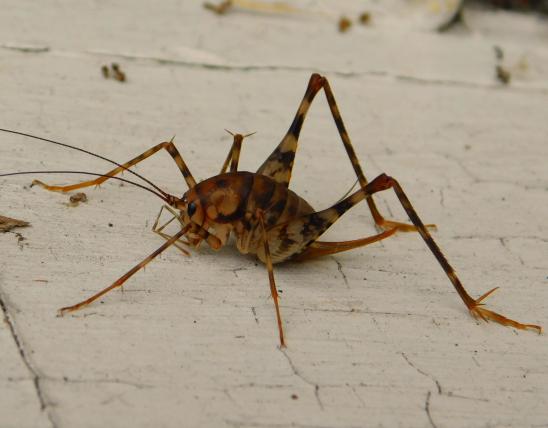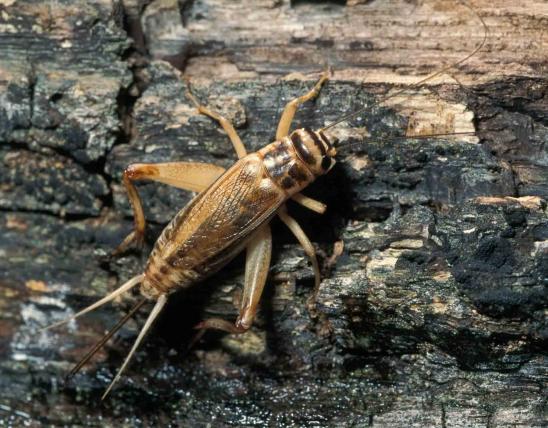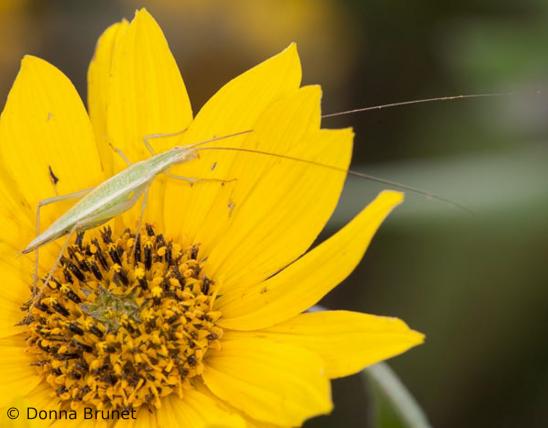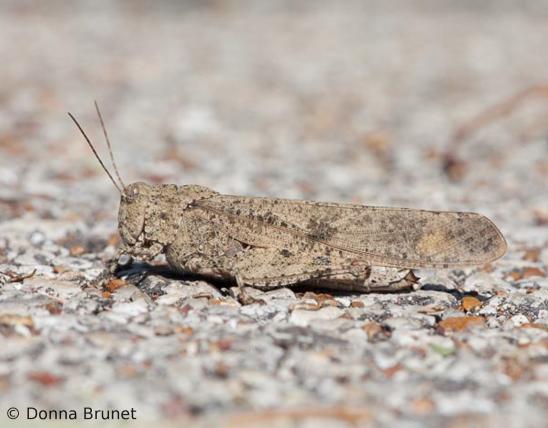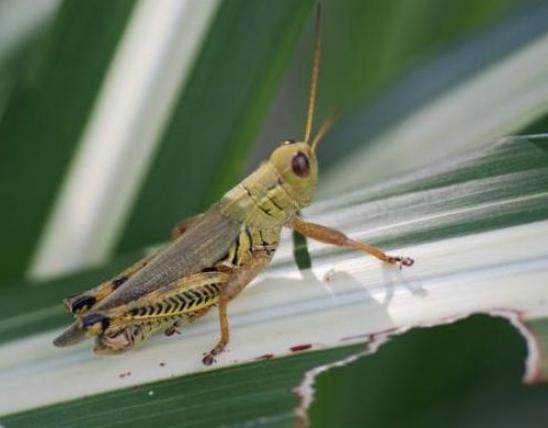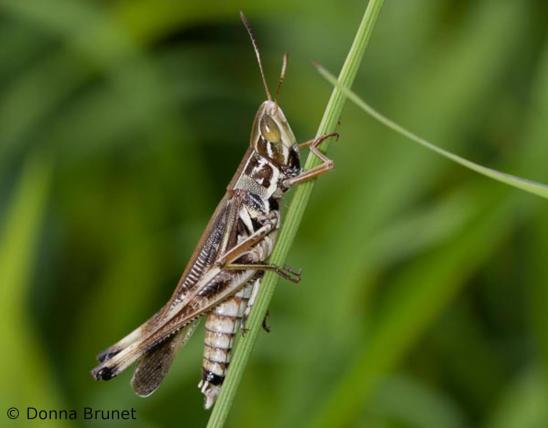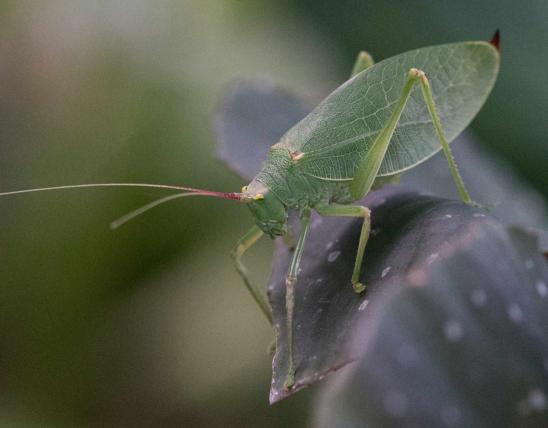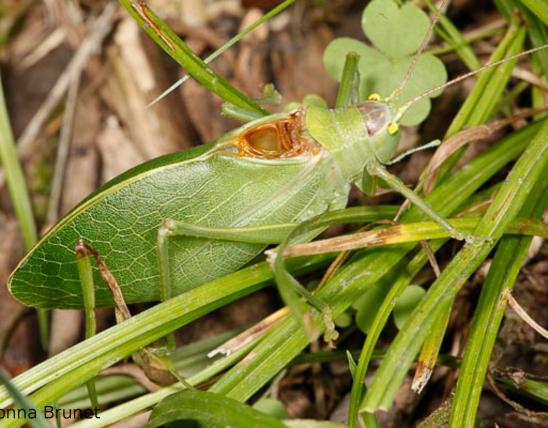
Field crickets and house crickets are celebrated singers. There are many species in North America, and they can be hard to tell apart. They have large heads, hind legs adapted for jumping, and stout, unmovable spines on the hind legs. Species may be black, brown, or tan. Adult females have a needlelike (but harmless) ovipositor extending outward from the abdomen; all have a pair of filament-like circi extending from the abdomen (each cercus functions like an antenna).
- The several members of genus Gryllus are usually shiny black, and the different species are often best separated by singing pattern.
- The house cricket, Acheta domesticus, is light brown or tannish overall; the tan head has three dark crossbands; the wings of adults extend beyond the tip of the abdomen.
Length: usually ½–1 inch (not counting appendages; varies with species and age of individual).

Statewide.
Habitat and Conservation
Field and house crickets are common and can be found in many habitats, especially grassy areas such as lawns, fields, pastures, prairies, roadsides, but also in woods. They sometimes enter houses and other buildings.
They are nocturnal; the sound of their chirping signifies “nighttime” to us.
House crickets (A. domesticus) are probably native to Eurasia but are found nearly worldwide, having traveled the globe with people. They are commonly sold for fish bait and as a live pet food.
Food
Field and house crickets are omnivores, nibbling at a wide variety of plant and animal matter, including leaves, fruits, grain, other insects, meat, and much more.
Sometimes field crickets damage crops, or chew on clothing when they enter homes.
Their broad diet and ability to sing has made them popular pets at different times in various cultures, as they can subsist on a variety of foods.
Status
Common.
Life Cycle
Most species overwinter as eggs, hatch in spring, and begin eating and growing. Like other insects, crickets molt several times as they grow. Immature crickets are called nymphs; they are smaller than adults, and their undeveloped wings are budlike or very small on the back. Their final molt gives them wings, and they are sexually mature.
Males chirp, rubbing rough portions of their wings together. By raising the wings at an angle, they form a resonating chamber sort of like a violin body. The calls attract females that are ready to mate and also warn off rival males.
Females deposit eggs under soil using their ovipositor.
Human Connections
Crickets have economic impacts as agricultural and household pests, but also as fish bait and pet food. People who have pet tarantulas, reptiles, or amphibians commonly buy farm-raised house crickets as pet food. Such crickets, raised in commercial settings, are safer for pets as they have not been exposed to pesticides; they also can be acquired during the winter, when it can be difficult to locate wild insects.
The chirping of crickets sets the mood for a quiet autumn evening, and beautiful evenings inspire camping and tourism.
Crickets have been favorite subjects of poetry, notably haiku, where their chirping traditionally evokes late summer and fall, loneliness, crying, or silence. Today, the word "crickets" is used to mean silence, as when an audience's collective response is so quiet you can hear crickets.
Crickets have also inspired folklore, myths, cartoon characters, and children’s stories. Think of Jiminy Cricket, one of the stars of Disney's Pinocchio movie, inspired by "the Talking Cricket" character in the 1883 Italian children's book the movie was based on. Charles Dickens's 1845 book The Cricket on the Hearth features a chirping cricket that is sort of a guardian angel for the various human characters living in a house (instead of chapters, the novel is divided into "chirps"). George Selden's 1960 children's book, The Cricket in Times Square, illustrated by Garth Williams, is beloved by many.
Starting thousands of years ago, certain species of crickets were kept as pets in China, first for their singing, but by the early 1100s also for cricket fighting. It continued as a special pastime for the ruling class until the early 1800s. Considerable artistry went into the making of special cricket cages of wood and bamboo, hollow gourds, and ceramic vessels. Even today, crickets remain a favorite pet in China. Japanese cricket-keeping also existed for thousands of years, but in that nation it has gone out of fashion during the last century. In America, pet crickets usually live in glass fish tanks or big jars set up as terrariums.
Cricket, the sport, is completely unrelated to the insects. The name apparently is derived from words meaning "crutch," "staff," "club," or "stick," referring to the cricket bat.
Ecosystem Connections
As omnivores, crickets recycle decaying organic materials, graze on plants, and eat insects. They pass nutrients from these basic forms into the form of their own bodies, which then become food for the animals that consume them.
They are preyed on by many animals, from insects (even other crickets) and spiders to birds to mammals to even people, in some countries.
They are also attacked by parasitic and parasitoid insects that require them as hosts:
- Horsehair worms, for example, are famous as parasitoids of crickets. One of the freakier things to see in the insect world is a several-inches-long horsehair worm emerging from the body of its unlucky host cricket. When people witness this, it's usually in a pet water dish or other ground-level container of water. Some horsehair worms, as they reach adult size, chemically infect the brain of their host (such as a cricket), compelling it to seek water to drink, wet, swim, and/or drown itself: the perfect environment for the adult horsehair worm, which is aquatic.
- Several types of wasps look for crickets, too; one of these is the steel-blue cricket-hunter wasp (Chlorion aerarium). Females capture crickets in genus Gryllus, subduing them with a sting, and drag them by their antennae into nest burrows. The female places eggs on the crickets, and the wasp young eat the crickets as they grow.
